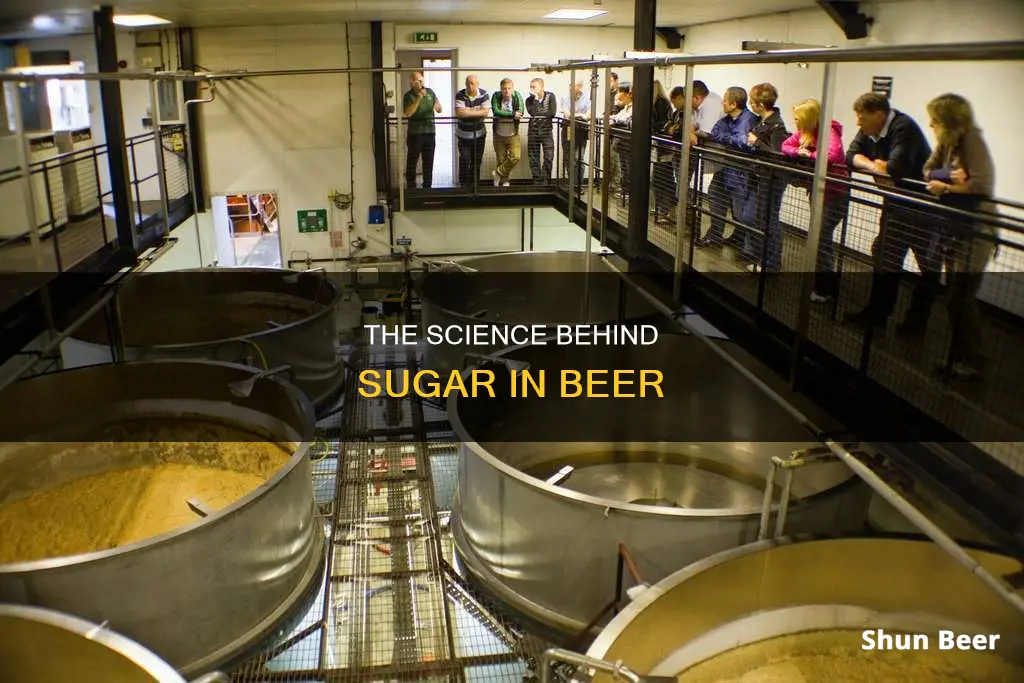
The sugar in beer is created during the brewing process, specifically during the malting and mashing steps. During malting, grains (typically barley) are soaked in hot water to germinate, then dried to halt further growth. This process converts starches in the grains into simple, fermentable sugars. The resulting sweet, malty liquid is known as wort, which is then boiled with hops or other spices, cooled, and filtered. At this point, yeast is added to the wort to begin fermentation, during which the sugars are converted into alcohol and carbon dioxide, creating beer.
What You'll Learn

Fermentation
The length of the fermentation process is entirely up to the yeast. However, brewers can change certain conditions to shorten or lengthen this timeframe, such as controlling the fermentation temperature. Every yeast strain has a temperature range they work best in, and different temperatures within that range can affect the fermentation ability of different yeasts. The general rule is that the hotter the fermentation, the more likely you are to get off-flavours and unwanted attributes in the beer.
The progress of the fermentation is usually monitored by following the specific gravity drop and/or increase in alcohol content. Yeast growth and alcohol production deplete the sugar concentration, and the pH falls as nitrogenous materials are used up and the yeast secretes organic acids. Flavor compounds are generated during yeast growth, although some volatile components are lost with the exhaust carbon dioxide.
The fermentation temperature is critical in controlling the outcome of fermentation and has a significant impact on the development of flavour. Ales are generally fermented in the temperature range of 16°C to 22°C (61°F–72°F) using top-fermenting strains, whereas lagers are fermented much cooler, at 9°C–14°C (48°F–57°F), using bottom-fermenting strains.
Brewing vessels are equipped with cooling equipment to moderate yeast flocculation, which is necessary at the end of fermentation to facilitate yeast separation. If applied too early, it can cause incomplete fermentation and leave excessive levels of diacetyl in the finished beer.
Once the beer is finished fermenting, it is advisable to let the beer rest for a few days post-fermentation. This will allow the beer to settle and clear, with the yeast flocculating at the bottom of the fermenter. If possible, reducing the temperature during this stage can assist in clearing the beer.
During the mashing stage, malted grains are roasted, milled, and soaked in hot water. The result is a sugar-containing liquid called wort. The yeast added during the fermentation stage then converts the sugars in the wort into alcohol and carbon dioxide.
While not all the sugar is converted, some remain in the final product. This influences the beer's flavour and body. The most common type of sugar in beer is maltose, which is made out of two glucose molecules. However, the wort also contains other sugars such as maltotriose, glucose, sucrose, and fructose.
Sour Beers: High Sugar Content or Healthy Choice?
You may want to see also

Malted grains
After the grains have soaked up enough water, they are transferred to a large room where they are aerated, turned regularly, and held at a specific temperature to encourage germination. At this stage, the grain is called "green malt". The goal is to stop the germination process before the grain takes root and grows into a new plant, which is done by drying the grain with heat in a kiln.
The malted grains are then transferred to the brewery, where they are added to hot water, encouraging the conversion of starch into simple sugars. This sweet, malty liquid is known as wort, which is what yeast feeds on during fermentation. As the yeast digests these sugars, it produces alcohol and carbon dioxide, leading to the creation of beer.
The specific enzymes activated during malting are primarily two types of amylases: α-amylase and β-amylase. These enzymes break down the starch in the grains into simpler sugars, which can be digested by the yeast during fermentation. β-amylase produces fermentable sugars such as maltose, which are turned into alcohol and carbon dioxide. On the other hand, α-amylase produces unfermentable sugars such as maltodextrins, which remain in the brew, adding body and a sweet, malty flavour.
By controlling the temperature of the brew, brewers can determine the ratio between the two types of sugar and, therefore, the final amount of alcohol and malty flavours in the beer. Malted grains play a crucial role in creating the sugar content in beer and influencing the flavour, body, and alcohol content of the final product.
Beer and Sugar: Friends or Foes?
You may want to see also

Wort
The resulting mixture is called "sweet wort" until hops are added, after which it is called "hopped or bitter wort". The addition of hops is generally done in three parts at set times. The first addition is bittering hops, which are boiled in the wort for approximately one hour to one and a half hours to extract resins for bittering. Flavouring hops are added next, typically 15 minutes from the end of the boil, followed by finishing hops toward the end of or after the boil to extract oils for flavour and aroma.
At the end of boiling, the hot wort is quickly cooled and transferred to a separate fermentation vessel, where yeast is added to begin the fermentation process. Wort also contains crucial amino acids that provide nitrogen to the yeast, as well as more complex proteins that contribute to beer head retention and flavour.
The sugars in a typical wort made from 2-row barley base malt are primarily maltose (50%), followed by maltotriose (18%), glucose (10%), sucrose (8%), fructose (2%), and dextrins (12%). Yeast metabolises these sugars in different ways, with most strains consuming monosaccharides like glucose and fructose first, followed by disaccharides like sucrose, and finally trisaccharides like maltose and maltotriose.
Sugar in Beer: How Many Teaspoons?
You may want to see also

Yeast
During fermentation, the primary beer yeast species, known as Saccharomyces cerevisiae, produces energy for its cellular metabolism by converting certain sugars into carbon dioxide, alcohol, and fermentation by-products. This process is called glycolysis, and it is an ancient metabolic pathway that probably developed around 3.5 billion years ago when no oxygen was available in the environment.
There are two main types of brewing yeast, classified according to whether fermentation takes place at the top of the fermenter (top-fermenting) or near the bottom (bottom-fermenting). Beer yeast that prefers warmer temperatures and works near the top of the fermenter is known as "ale yeast". Ale yeast also tends to ferment best at hotter temperatures, with most preferring temperatures between 50°F and 70°F. Ale yeasts are responsible for a wide range of beer styles, including witbiers, stouts, ambers, tripels, saisons, and IPAs.
On the other hand, "lager yeast" likes to hang out at the bottom of the fermenter and thrives in colder temperatures. Saccharomyces pastorianus is a bottom-fermenting lager yeast that was originally found and cultivated by Bavarian brewers about 200 years ago. Lager yeast prefers temperatures between 48°F and 58°F. This yeast is responsible for beer styles like Pilsners, lagers, märzens, and bocks.
Sugar in Beer: How Much is Too Much?
You may want to see also

Beer gravity
The OG is an important metric for brewers, as it helps them monitor the health and progress of the fermentation. By tracking the decline in specific gravity over time, brewers can determine when the fermentation is complete. Additionally, consistent OG readings from batch to batch ensure brewing and ingredient quality.
The final gravity (FG) is another crucial gravity reading that takes place after fermentation. The difference between the OG and FG is used to calculate the beer's alcoholic content (ABV). Beers with a higher OG will typically have a higher ABV, while session beers and dry, less sweet beers will have a lower gravity and alcoholic content.
The formula for calculating ABV is:
ABV = (OG - FG) x 1.05) / FG) / 0.79
To summarise, beer gravity is a critical aspect of brewing that helps brewers monitor the fermentation process and determine the final alcohol content of their beers. It is influenced by the amount of dissolved sugars in the wort and plays a significant role in the overall quality and characteristics of the final beer.
Sugar in Beer: How Many Grams?
You may want to see also
Frequently asked questions
Beer is made from yeast, grains, spices, and water.
Grains are soaked, germinated, and dried in a process called malting. This process converts starches in the grains into fermentable sugars. The malted grains are then soaked in hot water to create a sweet liquid called wort. Yeast is then added to the wort to ferment it, which converts sugars into alcohol and carbon dioxide.
The most common type of sugar created during the beer-making process is maltose, which is made from two glucose molecules.
Ales are fermented with Saccharomyces cerevisiae, a top-fermenting yeast that works best at warmer temperatures. This yeast tends to ferment quickly and can digest a variety of sugars, which can lead to a higher alcohol content and lower sugar content. Lagers, on the other hand, use Saccharomyces pastorianus, a bottom-fermenting yeast that prefers cooler temperatures and ferments more slowly and cleanly, resulting in a slightly higher sugar content.
Beer, especially light beer, generally has less sugar than other alcoholic beverages such as sweet dessert wines, liqueurs, and flavored drinks like hard cider.







